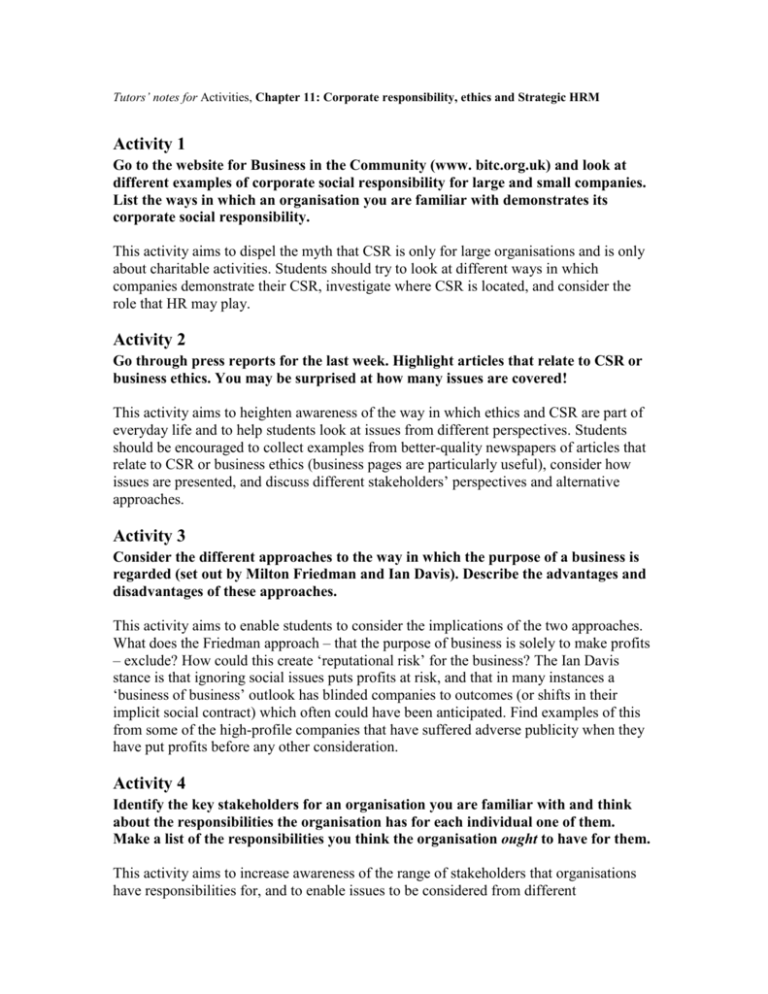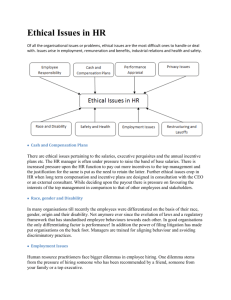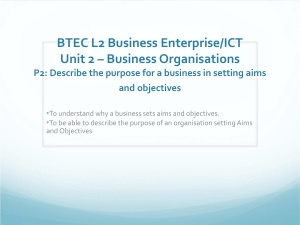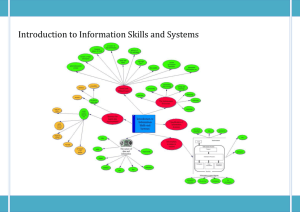Activity 10
advertisement

Tutors’ notes for Activities, Chapter 11: Corporate responsibility, ethics and Strategic HRM Activity 1 Go to the website for Business in the Community (www. bitc.org.uk) and look at different examples of corporate social responsibility for large and small companies. List the ways in which an organisation you are familiar with demonstrates its corporate social responsibility. This activity aims to dispel the myth that CSR is only for large organisations and is only about charitable activities. Students should try to look at different ways in which companies demonstrate their CSR, investigate where CSR is located, and consider the role that HR may play. Activity 2 Go through press reports for the last week. Highlight articles that relate to CSR or business ethics. You may be surprised at how many issues are covered! This activity aims to heighten awareness of the way in which ethics and CSR are part of everyday life and to help students look at issues from different perspectives. Students should be encouraged to collect examples from better-quality newspapers of articles that relate to CSR or business ethics (business pages are particularly useful), consider how issues are presented, and discuss different stakeholders’ perspectives and alternative approaches. Activity 3 Consider the different approaches to the way in which the purpose of a business is regarded (set out by Milton Friedman and Ian Davis). Describe the advantages and disadvantages of these approaches. This activity aims to enable students to consider the implications of the two approaches. What does the Friedman approach – that the purpose of business is solely to make profits – exclude? How could this create ‘reputational risk’ for the business? The Ian Davis stance is that ignoring social issues puts profits at risk, and that in many instances a ‘business of business’ outlook has blinded companies to outcomes (or shifts in their implicit social contract) which often could have been anticipated. Find examples of this from some of the high-profile companies that have suffered adverse publicity when they have put profits before any other consideration. Activity 4 Identify the key stakeholders for an organisation you are familiar with and think about the responsibilities the organisation has for each individual one of them. Make a list of the responsibilities you think the organisation ought to have for them. This activity aims to increase awareness of the range of stakeholders that organisations have responsibilities for, and to enable issues to be considered from different perspectives. Stakeholders are generally regarded as ‘anyone who has an interest in or is affected by the activities of an organisation’. This includes employees, managers, shareholders, customers, suppliers, and entire communities (local and global – including those further down the supply chain). Activity 5 For the four areas of Strategic HRM referred to above – recruitment, training, reward management and employee relations – list the issues that must be considered by any company that operates across different countries. (See also Chapters 4, 5 and 6 for further discussion of these areas.) This activity aims to get students to consider how policies and practices of HR in specific areas pose particular ethical dilemmas when operating in a global context. For example, recruitment may pose ethical dilemmas in relation to decisions about advertising, to the treatment of applicants from different countries, or to selection processes. In training, there may be ethical dilemmas in relation to what standards are applied and how competencies/qualifications are assessed and used. In reward management, further ethical dilemmas may centre on what policies apply to ‘home’ and ‘local’ employees, how pay rates are set and what other benefits must be considered. In employee relations, ethical dilemmas may centre on what processes exist for employee consultation and communication. Activity 6 Think of another ethical dilemma that can occur in the workplace (use either one from your own experience or one you are familiar with from press reports or family/friends). Then review the main ethical theories discussed in this chapter and set out how your approach to the ethical dilemma might differ according to which ethical theory you adopt. Encouraging students to use different perspectives and decision-making frameworks can help to inform the resolution of ethical dilemmas. Suggest that the dilemma is considered using different viewpoints and subsequent outcomes. Encourage students to be on the lookout for ethical dilemmas when going about their everyday life. Activity 7 Think about the nature of your own psychological contract in organisations you have worked in. Consider the extent to which your own and the organisations’ ethics and values and issues of trust, fairness and justice affected your psychological contract. This activity aims to encourage reflection on how these issues can impact upon the fundamentals of the employment relationship. The exercise is most successful when students are encouraged to share their own experiences, but it may also be appropriate to ask students who have limited organisational experience to ask people they know about examples that have involved issues of trust, fairness and justice. Activity 8 List what you see as the key differences in the application of contrasting HRM perspectives to the workplace. Students with organisational experience often find value in discussing their role and organisation with others from different companies and organisational settings. It is easy to think (especially when working at an organisation for a while or in a first job) that the way an organisation carries out its HR strategy, policies and practices is the way to do things. This activity encourages students to consider alternative ways of viewing approaches to HRM and to use different perspectives to work out how they may affect HR strategy, policy and practice. Activity 9 Go to the Levi Strauss website (www.levistrauss.com/company/valuesandvision). List two examples of how each of the core values translates into activities within the company. (See also www.levistrauss.com/citizenship/levistraussfoundation.) Many companies have values, but not all organisations fully integrate their values into the strategies, policies and practices in the organisation. This is just one example of a company which sees that its values are key drivers of the business. Students could consider organisations they are familiar with and track how the values of that organisation are integrated into the organisation. Alternatively, they should consider the strategies, policies and practices of organisations and list what these say about the organisations’ values. Activity 10 Case studies of the companies that took part in the research for the CSR competency framework are detailed on the CSR Academy website, www.csracademy@bitc.org.uk. Select three from the following examples to research. This activity aims to familiarise students with the CSR competency framework. The competencies are: Understanding society – understanding the role of each player in society, including government, business, trade unions, non-governmental organisations and civil society Building capacity – external partnerships and creating strategic networks and alliances Questioning ‘business as usual’ – openness to new ideas, challenging others to adopt new ways of thinking, and questioning ‘business as usual’ attitudes Maintaining stakeholder relations – identifying stakeholders, building relations externally and internally, engaging in consultation and balancing demands Taking a strategic view – taking a strategic view of the business environment Harnessing diversity – respecting diversity and adjusting the approach to different situations. Take each of these competencies and in going through the examples, consider where the organisation could be positioned according to the five levels of attainment for each characteristic. These range from basic awareness to understanding, application, integration and leadership.







